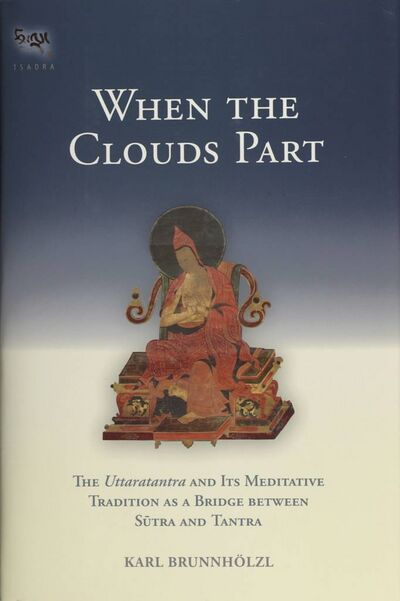- Abbreviationsix
- Prefacexi
- Acknowledgmentsxiii
- The Sūtra Sources of the Tathāgatagarbha Teachings3
- Different Ways of Explaining the Meaning of Tathāgatagarbha53
- Explanations of Tathāgatagarbha in Indian Texts54
- Tathāgatagarbha as the Emptiness That Is a Nonimplicative Negation55
- Tathāgatagarbha as Mind’s Luminous Nature57
- Tathāgatagarbha as the Ālaya-Consciousness63
- Tathāgatagarbha as a Sentient Being63
- Tathāgatagarbha as the Dharmakāya, Suchness, the Disposition, and
Nonconceptuality64
- Tibetan Assertions on Tathāgatagarbha65
- Explanations of Tathāgatagarbha in Indian Texts54
- The History and Transmission of "The Five Dharmas of Maitreya" from
India to Tibet81 - The Mahāyānottaratantra (Ratnagotravibhāga) and the
Ratnagotravibhāgavyākhyā93- Texts and Authorships93
- The Meanings of the Titles Ratnagotravibhāga and
Mahāyānottaratantraśāstra95
- The Uttaratantra and Its Relationship with Yogācāra105
- The Meditative Tradition of the Uttaratantra and Shentong123
- The Two Approaches of Explaining the Uttaratantra123
- The Shentong Lineages and the Meditative Tradition of the
Uttaratantra in the Jonang, Kagyü, and Nyingma Schools131 - Indian Forerunners of Shentong, Early Tibetan Shentongpas, and Their
Connection to the Uttaratantra140
- The Uttaratantra and Mahāmudrā151
- Sūtra Mahāmudrā, Tantra Mahāmudrā, and Essence Mahāmudrā151
- The Sūtra Sources of Mahāmudrā165
- Maitrīpa’s Mahāmudrā of "Mental Nonengagement"167
- Connections between Maitrīpa’s Mahāmudrā and the Uttaratantra177
- Other Indian Nontantric Treatises on Mahāmudrā184
- Gampopa’s Mahāmudrā and the Uttaratantra190
- The Third Karmapa, Rangjung Dorje202
- The Eighth Karmapa, Mikyö Dorje206
- Tagpo Dashi Namgyal212
- Padma Karpo214
- The Eighth Situpa, Chökyi Jungné216
- Other Kagyü Masters on Mahāmudrā and the Uttaratantra227
- Gö Lotsāwa’s Unique Mahāmudrā Interpretation of the Uttaratantra243
- The Geden Kagyü Tradition of Mahāmudrā278
- Overview of the Indian and Tibetan Texts Presented in This Book283
- The Uttaratantra and Ratnagotravibhāgavyākhyā283
- The Indian Texts on the Uttaratantra288
- The Tibetan Commentaries301
- Instruction Manuals314
- Ratnagotravibhāga Mahāyānottaratantraśāstra—An Analysis of the Jewel Disposition, A
Treatise on the Ultimate Continuum of the Mahāyāna331- Chapter 1: The Three Jewels and the Tathāgata Heart337
- Chapter 2: Awakening415
- Chapter 3: The Buddha Qualities429
- Chapter 4: Buddha Activity437
- Chapter 5: The Benefit455
- Pith Instructions on "The Treatise on the Ultimate Continuum of the
Mahāyāna" by Sajjana461
- A Commentary on the Meaning of the Words of the "Uttaratantra"473
- A Commentary on "The Treatise on the Ultimate Continuum of the
Mahāyāna," The Heart of the Luminous Sun by Dashi Öser695
- Instructions on "The Ultimate Continuum of the Mahāyāna" by Mönlam
Tsültrim777
- The Repository of Wisdom by Mönlam Tsültrim789
- The Heart of the Matter of Luminosity by Mönlam Tsültrim797
- Pith Instructions on the Wisdom at the Point of Passing when about to
Die by Mönlam Tsültrim801
- The Lamp That Excellently Elucidates the System of the Proponents of
Shentong Madhyamaka by the Eighth Karmapa803
- Guiding Instructions on the View of Great Shentong Madhyamaka— Light
Rays of the Stainless Vajra Moon by Jamgön Kongtrul831
- Appendix 1: Selected Indian and Tibetan Comments on Uttaratantra I.27–2855
- Appendix 2: Selected Indian and Tibetan Comments on Uttaratantra I.154–5901
- Appendix 3: Indian and Tibetan Comments on Abhisamayālaṃkāra V.2943
- Appendix 4: The Emptiness Endowed with All Supreme Aspect953
- Appendix 5: The General Explanation of Tathāgatagarbha in Yeshé Dorje's
Commentary on the Uttaratantra963
- Appendix 6: The Presentation of the Purpose of Teaching Tathāgatagarbha in
Yeshé Dorje's Commentary on the Uttaratantra969
- Appendix 7: Comparison of the First Six Topics of the Fourth and Fifth Vajra
Points in the Uttaratantra with the Same Six Topics in the Mahāyānasūtrā-
laṃkāra and the Mahāyānasaṃgraha979
- Appendix 8: A Letter from Stainless Expanse and Awareness— a Casual
Summary of the "Uttaratantra"983
- Notes985
- English–Sanskrit–Tibetan Glossary1227
- Tibetan–Sanskrit–English Glossary1231
- Selected Bibliography1235
- Index1259



